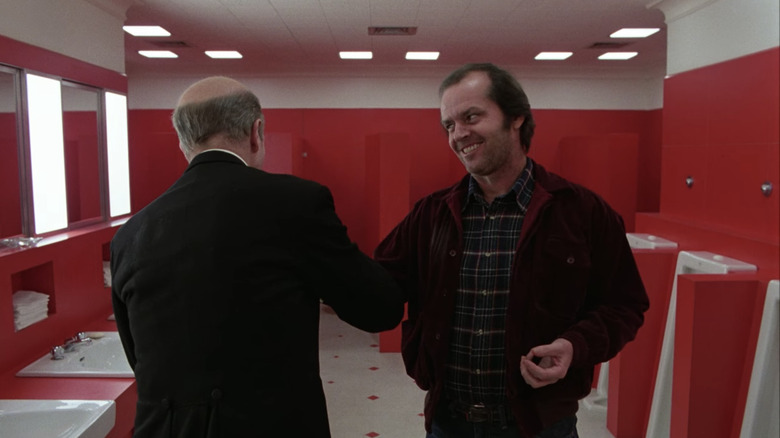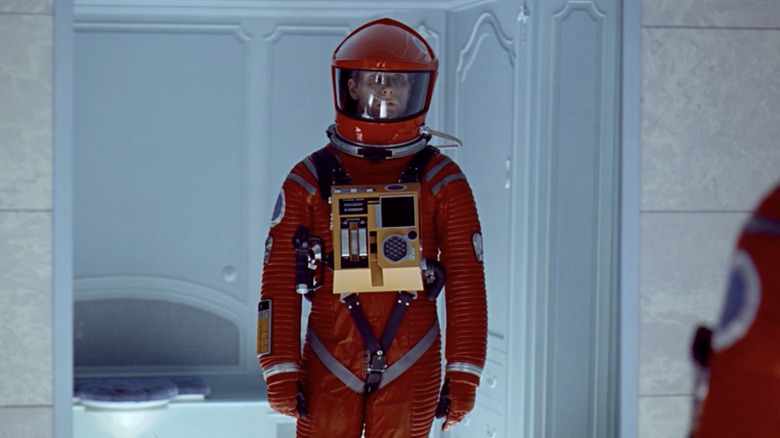Why Bathrooms Always Mean Bad News In Stanley Kubrick Films
Weirdly enough, some of the most famous scenes in Stanley Kubrick's filmography are set in and around bathrooms. Perhaps the most obvious film to illustrate this is "The Shining," which sticks Jack Torrance, played by Jack Nicholson, in several scenes involving bathrooms in the Overlook Hotel.
A bathroom is where Jack encounters the frightening lady in Room 237, who appears to him first as a beautiful naked woman, rising up out of the bathtub. They kiss and embrace before she reveals her true form as the rotting corpse of an old crone. It's in another, more dynamic bathroom where Jack also converses with the ghost of Grady, the hotel's former caretaker, who encourages him to "correct the problem" of his wife and son by killing them. As Jack takes after the two of them with an axe, Wendy Torrance (Shelley Duvall) also hides from him — you guessed it — in a bathroom, though Jack soon chops through the door and delivers the immortal line, "Here's Johnny!"
This tendency of Kubrick's to set scenes in bathrooms is by no means limited to "The Shining." Looking back over his filmography, there are a number of other scenes that make it clear the director of "Full Metal Jacket," "2001: A Space Odyssey," "Lolita," and more, was unusually fixated on bathrooms for some reason.
Movies often skip over the unromantic part where characters respond to nature's call because, let's face it, who wants to see them sitting on the toilet? There's no real reason to show it unless it has some narrative purpose. But that's just it, according to one thought-provoking film essay. In "Animals in My Head: Stanley Kubrick's Preoccupation with Bathrooms," Jeff Westerman argues that Kubrick's apparent bathroom fascination did have a thematic purpose.
The Life of the Mind vs. the Body's Needs
Westerman writes that, in Kubrick's films, the bathroom is "the room in which the human pretense of civilization falls away and the one place in which our animal instincts are revealed, because as Erving Goffman said, it is the one 'backstage area' where we take off our social masks and where truth is spoken."
This is why Jack denies seeing the woman in room 237, because she represents, in some sense, his own hidden nature. Jack resents his wife and son for interfering with his writing, but his murderous instincts don't fully awaken until he's in the bathroom communing with Grady.
Likewise, other Kubrick characters reveal their true selves in the bathroom. It's where Humbert Humbert (James Mason) sits writing his secret diary in "Lolita." It's where Dave Bowman (Keir Dullea) finds himself after he's traveled through the Star Gate in "2001: A Space Odyssey." Gazing at himself in the mirror like Narcissus, Dave experiences what we've called "the indignity of watching himself grow older."
That scene in particular is one that shows how Kubrick uses the bathroom to remind his characters that, no matter how lofty their egocentric human aspirations might be, they are still essentially animals caged to their corporal forms. The highfalutin "life of the mind," as the Coen Brothers character Barton Fink once labeled it, will always be beholden to the needs of the body, which is subject to aging and the ravages of time. Going by this view, it's no coincidence when, just prior to the murder-suicide in "Full Metal Jacket," R. Lee Ermey's drill sergeant confronts Pyle (Vincent D'Onofrio) and Joker (Matthew Modine) in the bathroom with the words, "What in the name of Jesus H. Christ are you animals doing in my head?"

